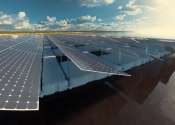Hydropower, hydraulic power, hydrokinetic power or water power is power that is derived from the force or energy of falling water, which may be harnessed for useful purposes. Since ancient times, hydropower has been used for irrigation and the operation of various mechanical devices, such as watermills, sawmills, textile mills, dock cranes, and domestic lifts. Since the early 20th century, the term is used almost exclusively in conjunction with the modern development of hydro-electric power, the energy of which could be transmitted considerable distance between where it was created to where it was consumed.
Another previous method used to transmit energy had employed a trompe, which produces compressed air from falling water, that could then be piped to power other machinery at a distance from the energy source.
Water's power is manifested in hydrology, by the forces of water on the riverbed and banks of a river. When a river is in flood, it is at its most powerful, and moves the greatest amount of sediment. This higher force results in the removal of sediment and other material from the riverbed and banks of the river, locally causing erosion, transport and, with lower flow, sedimentation downstream.









